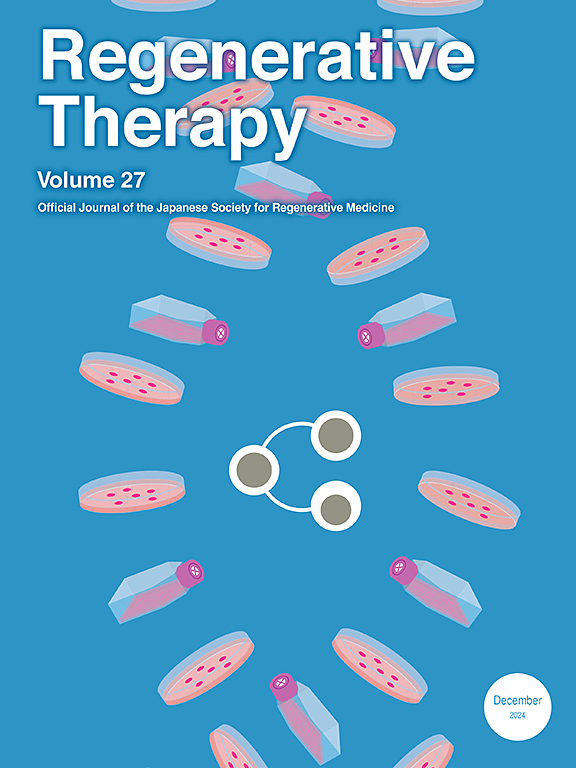Regenerative potential of PRP-based scaffolds in chronic wound healing: Mechanisms, advances, and therapeutic insights
IF 3.5
3区 环境科学与生态学
Q3 CELL & TISSUE ENGINEERING
引用次数: 0
Abstract
Introduction
Chronic wounds such as diabetic foot ulcers, venous leg ulcers, and pressure ulcers often remain trapped in the inflammatory phase due to oxidative stress, protease overactivity, and impaired cellular responses, particularly in diabetic conditions. These wounds require advanced therapeutic strategies beyond conventional care. Regenerative medicine—especially platelet-rich plasma (PRP)-based interventions—has emerged as a promising approach for enhancing wound repair.
Methods
This review examines recent developments in PRP-loaded scaffolds, focusing on their biological mechanisms, structural advantages, and clinical applications. It synthesizes findings from key studies that integrate PRP with natural and synthetic biomaterials, often combined with bioactive agents like adipose-derived stem cell exosomes.
Results
PRP-containing scaffolds promote wound healing through multiple pathways: enhancing cell proliferation, migration, angiogenesis, and extracellular matrix remodeling; reducing inflammation via M2 macrophage polarization; and facilitating collagen deposition. Their antibacterial properties and controlled release of growth factors such as VEGF and TGF-β1 further support tissue regeneration. Additionally, scaffold composition improves mechanical strength, elasticity, and growth factor bioavailability. Innovations such as GelMA/SFMA hydrogels and COL/PRP-ADSC-exos composites have shown superior outcomes in preclinical models.
Conclusions
PRP-based scaffolds offer a multifunctional platform for chronic wound treatment by combining biological activity with structural support. Despite existing challenges such as variability in PRP preparation and limited clinical data, ongoing research and emerging technologies hold strong potential to standardize and enhance these therapies for future clinical translation.

prp基支架在慢性伤口愈合中的再生潜力:机制、进展和治疗见解
慢性伤口,如糖尿病足溃疡、静脉性腿溃疡和压疮,由于氧化应激、蛋白酶过度活跃和细胞反应受损,经常停留在炎症期,特别是在糖尿病条件下。这些伤口需要超越传统护理的先进治疗策略。再生医学,特别是基于富血小板血浆(PRP)的干预,已经成为一种有前途的方法来加强伤口修复。方法综述了近年来prp负载支架的研究进展,重点介绍了prp负载支架的生物学机制、结构优势和临床应用。它综合了将PRP与天然和合成生物材料结合的关键研究结果,通常与生物活性剂如脂肪来源的干细胞外泌体结合。结果含spp支架通过促进细胞增殖、迁移、血管生成和细胞外基质重塑等多种途径促进创面愈合;通过M2巨噬细胞极化减轻炎症;促进胶原蛋白沉积。其抗菌特性和对VEGF、TGF-β1等生长因子的控释进一步支持组织再生。此外,支架组合物提高了机械强度、弹性和生长因子的生物利用度。GelMA/SFMA水凝胶和COL/PRP-ADSC-exos复合材料等创新产品在临床前模型中显示出优异的效果。结论sprp支架具有生物活性与结构支持相结合的特点,为慢性创面治疗提供了多功能平台。尽管存在诸如PRP制备的可变性和有限的临床数据等挑战,但正在进行的研究和新兴技术具有强大的潜力,可以标准化和增强这些治疗方法,以用于未来的临床转化。
本文章由计算机程序翻译,如有差异,请以英文原文为准。
求助全文
约1分钟内获得全文
求助全文
来源期刊

Regenerative Therapy
Engineering-Biomedical Engineering
CiteScore
6.00
自引率
2.30%
发文量
106
审稿时长
49 days
期刊介绍:
Regenerative Therapy is the official peer-reviewed online journal of the Japanese Society for Regenerative Medicine.
Regenerative Therapy is a multidisciplinary journal that publishes original articles and reviews of basic research, clinical translation, industrial development, and regulatory issues focusing on stem cell biology, tissue engineering, and regenerative medicine.
 求助内容:
求助内容: 应助结果提醒方式:
应助结果提醒方式:


